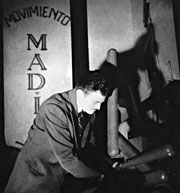Fernando Fallik was born in Kosice, Hungary, on April 26, 1924. He arrived in Argentina in 1928. He studied drawing and modelling, and attended briefly the Escuela de Bellas Artes Manuel Belgrano (Manuel Belgrano Fine Arts School).
In 1944 he was a member of the Editing group for Arturo magazine, where he published several theoretical writings and poems. He participated in the exhibitions hosted by Enrique Pichon Rivière at his house (October), and by Grete Stern at her house (December).
He was one of the charter members of the Madí Movement in 1946. Indefatigable impellor of that group, he organized several exhibitions, and contributed to its international promotion. He founded and directed the Arte Madí Universal magazine. In 1948 he was invited to exhibit the works of the group at the Salon Realités Nouvelles, in Paris.
The use of new materials drove him to experiment with Plexiglas, glass, and neon gas tubes. Later he added water to his interest in movement, and made Hydrokinetic sculptures, which he exhibited at the Galerie Denise René, Paris (1958). Ten years later, the Torcuato Di Tella Institute, Buenos Aires, hosted 100 obras de Kosice, un precursor (A Hundred Works by Kosice, A Pioneer).
In the early 70s he designed the Hydrospatial City, conceived as a new habitat suspended in space.
He published several books on subjects related to arts and poetry. He also produced monuments for open spaces in several countries.
He took part in the XXVIII International Biennial Exhibition of Venice (1956), the IV International Biennial Exhibition of San Pablo (1957), in the VI International Biennial Exhibition of San Pablo (1961), the III Coltejer Biennial Exhibition of Medellín (1972), and in the II Biennial Exhibition of Havana (1986).
In 1994 he received the Trajectory in Plastic Arts award granted by the Fondo Nacional de las Artes (National Arts Fund).
Among his most outstanding individual exhibitions, the Spatial Constructions and First Hydrospatial Sculpture exhibition at the Drian Gallery, London (1953) can be mentioned as well as the Hydrospatial City, at the Espace Cardin, Paris (1975); the Hydroespacial City, at the Planetarium of Buenos Aires (1979); Kosice, at the Hakone Open Air Museum, Tokyo (1982); Monumental Works by Kosice, at the Centro Cultural Recoleta, Buenos Aires (1985), and Kosice, Works 1944-1990, a retrospective exhibition at the Museo Nacional de Bellas Artes, Buenos Aires, in 1991. In 1999, the Centro Cultural Recoleta hosted the Gyula Kosice, Anticipations exhibition.
He took part in several collective exhibitions, such as Vanguardia de la década de los 40, Arte Concreto-Invención, Arte Madí, Perceptismo at the Museo Eduardo Sivori, Buenos Aires (1980), and Arte Madí at the Museo Nacional Centro de Arte Reina Sofía, Madrid (1997). He also took part in the Art from Argentina 1920/1994 exhibition opened at Modern Art Oxford, 1994, a travelling exhibition that after visiting several European countries, was closed at the Centro Cultural Borges in Buenos Aires, in 1995. His works were included in the Abstract Art from the Rio de la Plata, Buenos Aires and Montevideo 1933/53 exhibition, at The Americas Society of New York (2001).
At present he lives and works in Buenos Aires.
